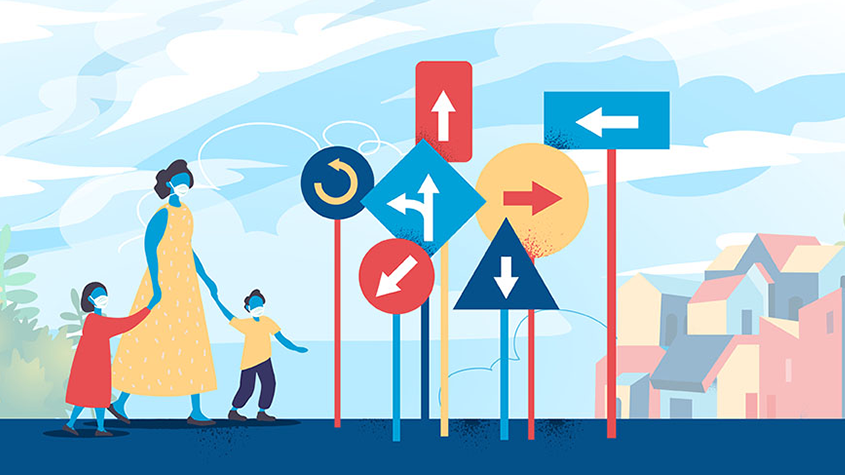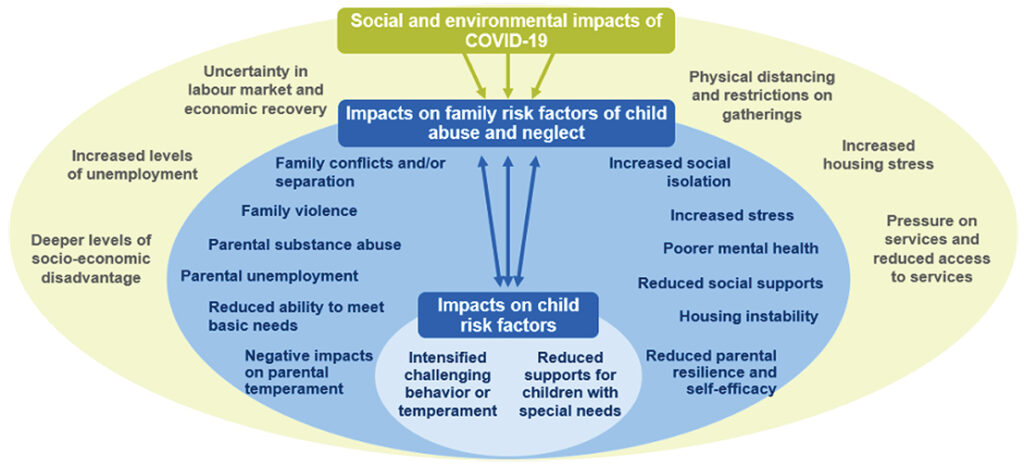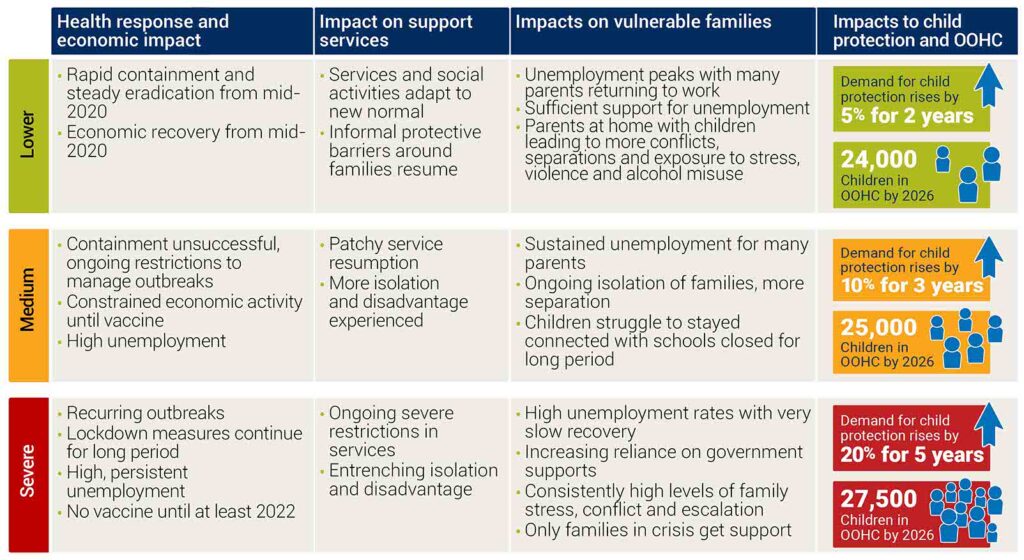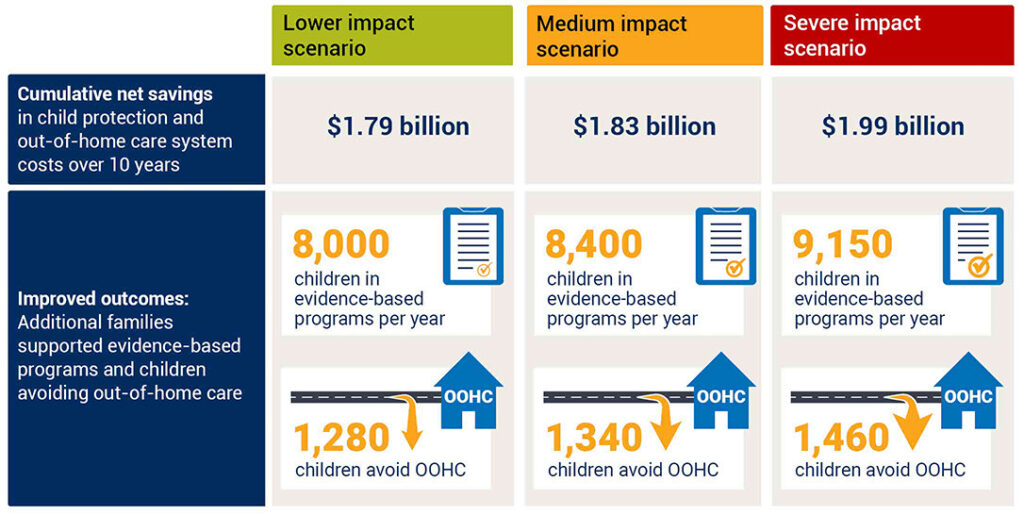
Scenario planning for times of great uncertainty
Covid-19 has had a massive impact on the social sector, not least in making planning for future demand extremely challenging. Using scenarios proved a valuable way to understand potential impacts on demand in the Victorian child and family services sector, given the many uncertainties.

- SVA partnered with Berry Street, Centre for Excellence in Child and Family Welfare and Victorian Aboriginal Child Care Agency to understand the emerging and future impact of Covid-19 on vulnerable families and children so that the sector could get a clearer sense of the potential increase in demand for child protection and out-of-home care in Victoria.
- This work built on an earlier report which demonstrated the economic case for additional government investment into targeted, early intervention programs to support more Victorian children to avoid out-of-home care.
- The team used scenario planning to demonstrate that under all scenarios more families will be in need of support due to Covid-19. Based on these scenarios, SVA was also able to quantify the additional social and economic benefits of investment in early intervention programs.
- Scenarios can be a useful tool to provide some certainty in a time of great uncertainty which could include contributing to a better understanding of demand for services or providing an evidence base for advocacy for additional funding.
The Covid-19 pandemic has had, and continues to have, a massive impact on the social sector: increasing the support needs of many individuals, families and communities, as well as the demand for those supports. It has also challenged service providers to adapt to new models of service delivery.
This makes it hard to make informed decisions about how and where to invest resources to strengthen capacity and better meet the needs of existing and new clients.
The social and economic impacts of Covid-19 have been felt by us all. However, unsurprisingly, the most vulnerable in our communities have been the hardest hit. People in low-socio economic areas and in lower skilled occupations are over-represented amongst those who have lost their jobs.1 People on low incomes have been more likely to face increased housing stress2. Many are people experiencing vulnerability for the first time, as emergency relief services experienced spikes in demand largely driven by people who had not sought charitable assistance before.3 In response, many social sector organisations have rapidly adapted to meet the greater need for services, working through the added complication of social distancing restrictions. Although restrictions have been largely eased in states other than Victoria, none can be certain that the pandemic is over and there is no doubt the economic consequences will last much longer.
Many of the impacts of Covid-19 will continue to be felt long after the pandemic itself is managed – when unemployment rates rise sharply in a recession, they take much longer to return to pre-crisis levels.4
In this context, social sector organisations anticipate demand for services to continue to grow, but at what rate, for which cohorts and in what geographies is still highly uncertain. This makes it hard to make informed decisions about how and where to invest resources to strengthen capacity and better meet the needs of existing and new clients.
The challenge now for social sector organisations is how to plan for this unknown future so that they’re well positioned to respond.
Using scenario planning to understand service demand in uncertainty
Modelling of the possible Covid-19 health trajectories and their potential impacts on the economy has been available from early on in the pandemic. Many analysts developed credible scenarios at the height of the pandemic’s uncertainty, for different rates of infection encouraging us to ‘flatten the curve’, and predictions on the numbers of job lost, unemployment rates, and the impact on GDP depending on how long shutdown measures might be in place. These scenarios were critical to enable governments, businesses and the community to navigate the pandemic’s uncertainty and to make plans should a particular scenario play out.
“The independent cost benefit work… has helped Berry Street and the sector advocate for a different approach to supporting families during this time.”
But to date, little attention has been paid to the social impacts of Covid-19, the potential demand for different services and how these impacts may vary under different health and economic scenarios. For social sector organisations this thinking is critical to enable robust planning for what could be a very large increase in both the need and nature of supports in the future.
Early in the pandemic, SVA Consulting partnered with Berry Street and the Centre for Excellence in Child and Family Welfare (the Centre) to examine these questions in the context of Victoria’s child protection system, a system already under significant pressure from existing forecast growth in demand. Specifically, Berry Street and the Centre wanted to understand the emerging and future impact of the Covid-19 pandemic on vulnerable families and children, to get a clearer sense of the potential increase in demand for child protection and out-of-home care in Victoria. The purpose of this analysis was to assist the sector to plan but also to advocate to government for the need for additional funding for early intervention programs.
This work built on an earlier report which demonstrated the economic case for additional government investment into targeted, early intervention programs to support more Victorian children to avoid out-of-home care.
Michael Perusco, CEO of Berry Street, says “The independent cost benefit work undertaken by SVA was seen by Government as a valuable piece of work and has helped Berry Street and the sector advocate for a different approach to supporting families during this time.”
Using scenario modelling, we drew on a range of data sources to extend projections of the trajectory of the pandemic and economic recovery into scenarios for how vulnerable families, social support services and, as a result, the demand for child protection services would be impacted. We demonstrated, not surprisingly, that under all scenarios more families will be in need of support due to Covid-19 and were able to quantify the additional social and economic benefits of investment in early intervention programs.
Our approach to developing scenarios
Given the lack of timely data (including data on how demand for child protection services has been impacted by the pandemic to date) and the many unknowns, we drew on different types of information as inputs to develop a set of future scenarios.
Our first step was to understand from research evidence what factors increase the risk of child abuse and neglect within a family, and therefore a child requiring child protection services, so that we could assess how Covid-19 had impacted these risk factors. The figure below describes a set of risk and protective factors at the child and family level that may be affected by the social and environmental impacts of Covid-19.5 The protective factors have been reframed as risk factors to reflect the impact of Covid-19.

The next step was to understand how and to what extent Covid-19 was affecting each of these risk factors, drawing on a range of sources. We looked for any reported indicators to date (of which there were numerous in the media, at the time of research in July 2020), drew on anecdotal reports from interviews with frontline child and family workers, and reviewed reported data about Covid-19 impacts from overseas. We also reviewed data from previous recessions, and other economic shocks and events (such as bushfires) to understand how these risk factors had been affected.
Some of the reported indicators in Australia we reviewed included:
- Family conflicts or separation: A survey by Relationships Australia found that people’s relationships with their partners have suffered, with 42% of respondents finding isolation has negatively affected their relationship6
- Family violence: A Monash University survey of Victorian family violence practitioners found that over half had observed an increase in the frequency and severity of family violence, and 42% reported an increase in ‘first-time family violence’ reporting by women7
- Unemployment: Victoria’s unemployment rate rose from 5.2% in March to 7.5% in June (and was 6.8% in July)
- Mental health: A Monash University study showed that levels of anxiety and depression have risen, with people who lost work during Covid-19 experiencing rates of psychological distress four times higher than typically seen in working age Australians8
- Parental substance abuse: The Foundation for Alcohol Research and Education found that 20% households reported buying more alcohol since the Covid-19 outbreak, and of these, 32% are concerned about the amount of alcohol they or a loved one is consuming9
- Housing stress: An ANU study found that the number of Australians who couldn’t pay their rent or mortgage on time more than doubled between April and May
- Ability to meet basic needs: The Salvation Army in Melbourne has seen tripling in demand10, with families and people who were newly unemployed among the largest groups served.
Anecdotal reports from child and family services workers highlighted the increased complexity of cases. Families already experiencing vulnerabilities were dealing with additional levels of stress as a result of changes such as job loss, social isolation, closure of schools and child care centres, and reduced access to supports.
We also drew on available projections and scenarios by other analysts on the possible trajectories of Covid-19, and assessed how the risk and protective factors might be affected. This included forecast unemployment rates by the Reserve Bank of Australia, and scenarios put forward by Deloitte Access Economics on the health response and impact and shape of the economic recovery.11 Extrapolating from the three scenarios framed by Deloitte, we developed three future scenarios on the potential impact of Covid-19 on vulnerable families and increased need for child protection services (see Figure 2 below).
These scenarios were:
- Lower: Constrained pandemic, faster recovery
- Medium: Prolonged pandemic, slower recovery
- Severe: Sever rolling pandemics, protracted recovery.

The magnitude of the increase in demand under each scenario (5%, 10%, and 20%) were informed by the emerging indicators of a rise in the risk factors and anecdotal reports, rather than through calculations due to limitations in the data available. The duration of the rise in demand (2, 3 and 5 years) was based on projections for how long it may take for unemployment rates to return to pre-Covid levels.
The strengthened case for early intervention to support children and families
Having formed these scenarios, we then calculated, using the modelling from our earlier research, how Covid-19 might impact the case for additional investment in early intervention. Our earlier cost benefit analysis was based on a set of assumptions around the extent to which evidence-based early intervention programs are able to reduce the risk of a child entering out-of-home care. This then leads to savings for government, as well as improved outcomes for the child and family.
Set out in the figure below, the modelling demonstrates that even in the lowest Covid impact scenario developed, targeted investment in early intervention over a 10-year period would deliver cumulative net savings of $1.79 billion, due to the avoided costs of out-of-home care. Most importantly 1,280 children would avoid entering out-of-home care per year. This would require an annual investment of $181 million to support 8,000 children per year in early intervention programs. A more severe scenario would deliver greater overall savings, assuming more children and families are supported in early intervention.

Getting ready to meet increased service demand due to Covid-19
Given the many uncertainties about the Covid-19 recovery, using scenarios is valuable for understanding the potential impacts on the demand for social sector supports. This approach can provide a more robust understanding of the impact of Covid-19 on the nature and type of demand. It can be valuable for organisations considering both the ongoing service response, and planning for future service delivery. This includes planning for the funding required to meet additional and more complex demand so services can be better positioned to respond.
“Our system must be about supporting families and children to thrive, not just survive.”
Many service sectors are likely to require increased investment to support new groups of people needing support as a result of Covid-19. Potentially, there will also be more complex needs across existing clients.
Scenarios can provide a strong evidence base in a time of uncertainty for advocacy to key funders (including government) of the need to invest in additional capacity.
The full report on the emerging impact of Covid-19 on families and potential increase in demand for child protection and out-of-home care in Victoria has enabled Berry Street and the Centre to strengthen their advocacy with the Victorian Government.
According to Deb Tsobaris, CEO, Centre for Excellence in Child and Family Welfare, “Our system must be about supporting families and children to thrive, not just survive. At the moment, it’s a game of survival – even more so in Stage 4 lockdown. This is a landmark report that is going to allow us to tell a story for some time.”
Keeping families together through Covid-19: report launch
Watch the webinar of the launch of Keeping families together through Covid-19: The strengthened case for early intervention with speakers from the Victorian Aboriginal Child Care Agency, Berry Street, Centre for Excellence in Child and Family Welfare and SVA.
The report supports the organisations’ call for broader reforms across the sector – shifting towards keeping families together through early intervention.
For other sectors, what is needed might be increased funding to support more clients, more complex client needs or more flexible service delivery.
One thing that we do know is that Covid-19 has had a significant impact on many, particularly those in our community who are most at risk. This will require a thoughtful response on the part of governments, social sector organisations and communities.
Authors: Nancy Tran & Susie King
1. Monash University Covid-19 Work and Health Study, reported by ACOSS, Taking the Temperature Briefing Paper 2: 22 June 2020
2. ANU, Number of Australians facing housing stress doubles, 30 June 2020
3. Salvation Army, ‘Newly vulnerable Aussies are turning to the Salvos during the Covid-19 pandemic‘, 19 May 2020; and St Vincent de Paul and Foodbank submissions to Senate Committee Inquiry into Covid-19, as reported by ACOSS, Taking the Temperature Briefing Paper 3: 6 July 2020
4. Grattan Institute, Shutdown: estimating the Covid-19 employment shock; Grattan Institute Working Paper No. 2020-03, April 2
5. Adapted from Australian Institute of Family Studies, Literature review, Risk and protective factors of child abuse and neglect, May 2017
6. Relationships Australia May 2020 Survey, Covid-19 and its Effects on Relationships, May 2020
7. Monash University, Responding to the Shadow Pandemic – Practitioner views on the nature of and responses to violence against women in Victoria, Australia during the Covid-19 restrictions, 8 June 2020
8. Monash University, Covid-19 Work and Health Study reported in The Conversation, ‘90% out of work with one week’s notice. These 8 charts show the unemployment impacts of coronavirus in Australia’, 28 April 2020
9. University of Melbourne, ‘Australia’s Covid-19 relationship with booze’, Rob Moodie and Tasmyn Soller, 1 May 2020
10. Salvation Army, ‘Newly vulnerable Aussies are turning to the Salvos during the Covid-19 pandemic‘, 19 May 2020
11. Deloitte Access Economics, Economic scenarios for the Covid-19 recovery, May 2020.






